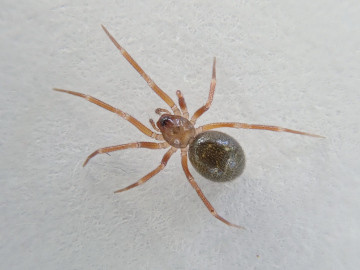Summary for Evansia merens (Araneae)
previous species | next species
National Distribution
Terms of Use. Double-click on map to go to region

Explore Regional Distribution
Please log on and add a note on this species
About this species
Recorded altitude range1m to 457m
Species text
DistributionAn inhabitant of north and west Britain, it is rarely found south and east of the line connecting the Humber and the Exe, though a record from Berkshire in 2003 extended its known range by some 100 km. This species has a wide Palaearctic distribution and is fairly widespread in north-western and central Europe, but has not been recorded from Belgium or the Netherlands.
Habitat and ecology
Open heaths and moorland. This myrmecophilous spider has been recorded from the nests of several ant species (Lasius niger, L. fuliginosus, Formica fusca, F. sanguinea). It occurs exclusively in dry peaty soils. In these habitats it is usually found within ant galleries beneath large rocks or logs. Both sexes are mature throughout the year, with egg-sacs (affixed to rocks within the ant galleries) produced between May and August. Our data show a peak of recorded females in May.
Status
Populations appear to be increasingly fragmented. Recorded from 24 hectads since 1992, but showing a decline of 58% in Area of Occupancy (from 45 to 19 hectads) from before that date, though the species' specialised habitat may have resulted in some under-recording.
Threats
Destruction of heathland associated with urban and agricultural development pose threats.
Management and conservation
Protect heathland from urban and agricultural development.
Text based on Dawson, I.K., Harvey, P.R., Merrett, P. & Russell-Smith, A.R. (in prep.). References
Adult Season
Habitats
background methodology
Recorded management for locations with Evansia merens
Recorded substrate and hydrology for locations with Evansia merens
Images
please log on and upload a new image for this speciesSee also A-Z Species Index - A-Z Picture Index - previous species | next species
